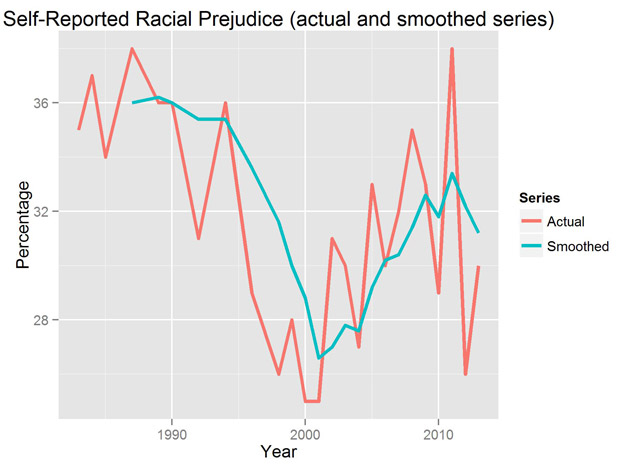
The survey also made the news recently because it has been suggested that the most recent results show that there has been a rise in racial prejudice over the last ten years. The survey has asked people about the extent of their prejudiced against people of other races at regular intervals since its inception. The figure below shows how the proportion of people who report themselves as being either very prejudiced or a little prejudiced has changed over this period.
The figure shows that the proportion of people reporting some prejudice fell throughout the 1980s and 1990s but whether it has risen over the last decade seems debatable. The proportion of the population reporting some level of racial prejudice is higher now than in 2002 but actually seems to have fallen since 2011. The figure also plots a smoothed series using a five year moving average of the results. The smoothed series is more supportive of an increase in prejudice over the last decade. However, I haven’t seen an explanation as to why the proportion of people reporting themselves as prejudiced has moved up-and-down a lot over the last five years. Rather than the trend in racial prejudice this would seem to be the more interesting feature of the recent changes in the data.

Although we might be becoming more prejudiced towards people from other races, we do seem to have become more tolerant on matters of sexuality. The survey has also regularly asked people about their attitudes to sexual relations between two adults of the same sex. The results from the survey show that the proportion of people reporting that homosexuality is either always or mostly wrong has fallen from over 70% in 1987 to around 30% in 2012.
In many cases where we see overall attitudes changing quickly, it is likely that changes in attitudes between birth cohorts are important. Changes between birth cohorts can produce rapid changes in overall attitudes because people often form their basic attitudes when they are young and then don't change them much with age. The overall pattern of change in the population is then due to older cohorts dying out and being replaced by younger cohorts who, in this case, have more open attitudes to issues concerning sexuality. The figure below shows the variation over time in the proportion of people reporting that homosexuality is wrong by decade of birth. The figure shows that there are important differences in attitudes between cohorts with younger cohorts showing more tolerant attitudes than older cohorts.

For all cohorts, the figure also shows that the proportion of respondents reporting that homosexuality is wrong has fallen over time within each cohort. This could be due to either changes in people’s attitudes with age or changes in society that are so general that they effect all cohorts. Because the survey does not interview the same people from year-to-year, however, we can’t distinguish which of these explanations are more important.
While surveys with a repeated cross-sectional design, like the British Social Attitudes Survey, are very useful for studying overall levels of change, longitudinal surveys which follow the same people over time are needed to tell us more about how overall trends are produced. People who run longitudinal surveys are always cautious, however, about asking their respondents about topics that might be considered intrusive because of a concern that they might leave the survey.
In consequence, we know far less about how individual attitudes change over time on topics such as sexuality, than we do about overall patterns of change at the population level. So which 'British values' is Michael Gove referring to? Yesterdays values or todays values? Individual values or population wide values? As the Social Attitudes Survey shows, they move over time and may not reflect the values we think are virtuous enough for our children.




